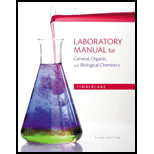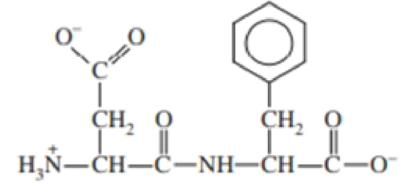
EBK LABORATORY MANUAL FOR GENERAL, ORGA
3rd Edition
ISBN: 9780321918352
Author: Timberlake
Publisher: YUZU
expand_more
expand_more
format_list_bulleted
Concept explainers
Textbook Question
Chapter 10, Problem 10.56AP
Aspartame, which is commonly known as Nutrasweet, contains the following dipeptide:

- a. What are the amino acids in aspartame?
- b. Give the three-letter abbreviation of the N-terminal amino acid.
- c. Circle the peptide bond
- d. Draw the structure of the isomer of this dipeptide where the C-terminal and N-terminal amino acids are switched.
Expert Solution & Answer
Want to see the full answer?
Check out a sample textbook solution
Students have asked these similar questions
A doctor gives a patient 10 Ci of beta radiation. How many betaparticles would the patient receive in 1 minute? (1 Ci = 3.7 x 1010d/s)
Part C
IN
H
N.
Br₂ (2 equiv.)
AlBr3
Draw the molecule on the canvas by choosing buttons from the Tools (for bonds and
+
e
(×)
H± 12D
T
EXP.
L
CONT.
ד
9. OA. Rank the expected boiling points of the compounds shown below from highest to lowest. Place your answer
appropriately in the box. Only the answer in the box will be graded. (3) points)
OH
OH
بر بد بدید
2
3
Chapter 10 Solutions
EBK LABORATORY MANUAL FOR GENERAL, ORGA
Ch. 10 - Prob. 10.1PPCh. 10 - Classify each of the amino acids in Problem 10.1...Ch. 10 - Prob. 10.3PPCh. 10 - Prob. 10.4PPCh. 10 - Prob. 10.5PPCh. 10 - Give the three-letter and one-letter abbreviations...Ch. 10 - Prob. 10.7PPCh. 10 - Prob. 10.8PPCh. 10 - Prob. 10.10PPCh. 10 - Prob. 10.11PP
Ch. 10 - Consider the following tripeptide: a. Circle the...Ch. 10 - Consider the following tripeptide: a. Circle the...Ch. 10 - Prob. 10.15PPCh. 10 - Prob. 10.16PPCh. 10 - Prob. 10.17PPCh. 10 - Prob. 10.18PPCh. 10 - Prob. 10.19PPCh. 10 - How many different tripeptides that contain one...Ch. 10 - Prob. 10.21PPCh. 10 - When a protein folds into its tertiary .structure,...Ch. 10 - Prob. 10.23PPCh. 10 - What type of interaction would you expect between...Ch. 10 - Prob. 10.25PPCh. 10 - Determine whether each of the following statements...Ch. 10 - Determine whether each of the following statements...Ch. 10 - Prob. 10.28PPCh. 10 - Prob. 10.29PPCh. 10 - How do beta-amyloid plaques form in a person with...Ch. 10 - List the type of attractive force disrupted and...Ch. 10 - List the type of attractive force disrupted and...Ch. 10 - Identity each of the following statements as...Ch. 10 - Prob. 10.34PPCh. 10 - Prob. 10.35PPCh. 10 - Prob. 10.36PPCh. 10 - Prob. 10.37PPCh. 10 - Prob. 10.38PPCh. 10 - Prob. 10.39PPCh. 10 - Prob. 10.40PPCh. 10 - Prob. 10.41PPCh. 10 - Describe how a substrate is drawn to an enzyme to...Ch. 10 - Which model for enzyme-substrate interaction...Ch. 10 - Describe the key difference in the lock-and-key...Ch. 10 - Prob. 10.45PPCh. 10 - Prob. 10.46PPCh. 10 - How would the following changes affect enzyme...Ch. 10 - Chymotrypsin is an enzyme located in the small...Ch. 10 - Prob. 10.49PPCh. 10 - Indicate whether each of the following describes a...Ch. 10 - Prob. 10.51APCh. 10 - Give the name and three-letter abbreviation for...Ch. 10 - Give ihe name and three-letter abbreviation for...Ch. 10 - Prob. 10.54APCh. 10 - Prob. 10.55APCh. 10 - Aspartame, which is commonly known as Nutrasweet,...Ch. 10 - Prob. 10.57APCh. 10 - Prob. 10.58APCh. 10 - Consider the amino acids glycine, proline, and...Ch. 10 - a. Draw the structure of ValAlaLeu. b. Would you...Ch. 10 - a. Draw the structure of SerLysAsp. b. Would you...Ch. 10 - Name the covalent bond that helps to stabilize the...Ch. 10 - Prob. 10.63APCh. 10 - Prob. 10.64APCh. 10 - Prob. 10.65APCh. 10 - Identify the level of protein structure associated...Ch. 10 - Prob. 10.67APCh. 10 - Prob. 10.68APCh. 10 - Prob. 10.69APCh. 10 - Describe the changes that occur in the primary...Ch. 10 - What types of covalent bonds can be disrupted when...Ch. 10 - Prob. 10.72APCh. 10 - Prob. 10.73APCh. 10 - Prob. 10.74APCh. 10 - Prob. 10.75APCh. 10 - Prob. 10.76APCh. 10 - Prob. 10.77APCh. 10 - Match the terms (1) ES, (2) enzyme, and (3)...Ch. 10 - Match the terms (1) active site, (2) lock-and-key...Ch. 10 - Prob. 10.80APCh. 10 - The enzyme trypsin catalyzes the breakdown of many...Ch. 10 - Prob. 10.82APCh. 10 - Prob. 10.83APCh. 10 - What type of interactions between an enzyme and...Ch. 10 - Prob. 10.85APCh. 10 - Prob. 10.86APCh. 10 - Prob. 10.87APCh. 10 - Chymoirypsin, an enzyme that hydrolyzes peptide...Ch. 10 - Prob. 10.89APCh. 10 - Prob. 10.90APCh. 10 - Prob. 10.91APCh. 10 - Prob. 10.92APCh. 10 - Prob. 10.93APCh. 10 - When lead acts as a poison, it can do so by either...Ch. 10 - Increasing the substrate concentration of an...Ch. 10 - Prob. 10.96APCh. 10 - Prob. 10.97APCh. 10 - Meats spoil due to the action of enzymes that...Ch. 10 - Prob. 10.99APCh. 10 - Fresh pineapple contains the enzyme bromelain,...Ch. 10 - Prob. 10.101CPCh. 10 - Prob. 10.102CPCh. 10 - How is the structure of a soap micelle (Chapter 7)...Ch. 10 - Prob. 10.104CPCh. 10 - Prob. 10.105CPCh. 10 - Prob. 10.106CPCh. 10 - What is an essential amino acid?Ch. 10 - Prob. 1IA.2QCh. 10 - Prob. 1IA.3QCh. 10 - Prob. 1IA.4QCh. 10 - Locate the side chain (R) on each amino acid...Ch. 10 - Prob. 1IA.6QCh. 10 - Prob. 2IA.1QCh. 10 - In the preceding condensation reaction, a...Ch. 10 - Prob. 2IA.3QCh. 10 - Prob. 3IA.1QCh. 10 - Lactase, the enzyme that hydrolyzes the...Ch. 10 - Prob. 3IA.3QCh. 10 - Prob. 3IA.4QCh. 10 - Prob. 3IA.5QCh. 10 - Prob. 3IA.6QCh. 10 - Prob. 3IA.7QCh. 10 - Prob. 1ICCh. 10 - Find out how oxygen binding to hemoglobin changes...Ch. 10 - Prob. 3ICCh. 10 - Find out how penicillin acts as an antibiotic.
Knowledge Booster
Learn more about
Need a deep-dive on the concept behind this application? Look no further. Learn more about this topic, chemistry and related others by exploring similar questions and additional content below.Similar questions
- There is an instrument in Johnson 334 that measures total-reflectance x-ray fluorescence (TXRF) to do elemental analysis (i.e., determine what elements are present in a sample). A researcher is preparing a to measure calcium content in a series of well water samples by TXRF with an internal standard of vanadium (atomic symbol: V). She has prepared a series of standard solutions to ensure a linear instrument response over the expected Ca concentration range of 40-80 ppm. The concentrations of Ca and V (ppm) and the instrument response (peak area, arbitrary units) are shown below. Also included is a sample spectrum. Equation 1 describes the response factor, K, relating the analyte signal (SA) and the standard signal (SIS) to their respective concentrations (CA and CIS). Ca, ppm V, ppm SCa, arb. units SV, arb. units 20.0 10.0 14375.11 14261.02 40.0 10.0 36182.15 17997.10 60.0 10.0 39275.74 12988.01 80.0 10.0 57530.75 14268.54 100.0…arrow_forwardA mixture of 0.568 M H₂O, 0.438 M Cl₂O, and 0.710 M HClO are enclosed in a vessel at 25 °C. H₂O(g) + C₁₂O(g) = 2 HOCl(g) K = 0.0900 at 25°C с Calculate the equilibrium concentrations of each gas at 25 °C. [H₂O]= [C₁₂O]= [HOCI]= M Σ Marrow_forwardWhat units (if any) does the response factor (K) have? Does the response factor (K) depend upon how the concentration is expressed (e.g. molarity, ppm, ppb, etc.)?arrow_forward
- Provide the structure, circle or draw, of the monomeric unit found in the biological polymeric materials given below. HO OH amylose OH OH 행 3 HO cellulose OH OH OH Ho HOarrow_forwardWhat units (if any) does K have? Does K depend upon how the concentration is expressed (e.g. molarity, ppm, ppb, etc.)? in calculating the response factorarrow_forwardDon't used hand raiting and don't used Ai solutionarrow_forward
- Don't used Ai solution and don't used hand raitingarrow_forwardOA. For the structure shown, rank the bond lengths (labeled a, b and c) from shortest to longest. Place your answer in the box. Only the answer in the box will be graded. (2 points) H -CH3 THe b Нarrow_forwardDon't used hand raitingarrow_forward
- Quizzes - Gen Organic & Biological Che... ☆ myd21.lcc.edu + O G screenshot on mac - Google Search savings hulu youtube google disney+ HBO zlib Homework Hel...s | bartleby cell bio book Yuzu Reader: Chemistry G periodic table - Google Search b Home | bartleby 0:33:26 remaining CHEM 120 Chapter 5_Quiz 3 Page 1: 1 > 2 > 3 > 6 ¦ 5 > 4 > 7 ¦ 1 1 10 8 ¦ 9 a ¦ -- Quiz Information silicon-27 A doctor gives a patient 0.01 mC i of beta radiation. How many beta particles would the patient receive in I minute? (1 Ci = 3.7 x 10 10 d/s) Question 5 (1 point) Saved Listen 2.22 x 107 222 x 108 3.7 x 108 2.22 x 108 none of the above Question 6 (1 point) Listen The recommended dosage of 1-131 for a test is 4.2 μCi per kg of body mass. How many millicuries should be given to a 55 kg patient? (1 mCi = 1000 μСi)? 230 mCiarrow_forwardDon't used hand raiting and don't used Ai solutionarrow_forwardDon't used hand raiting and don't used Ai solutionarrow_forward
arrow_back_ios
SEE MORE QUESTIONS
arrow_forward_ios
Recommended textbooks for you
 World of Chemistry, 3rd editionChemistryISBN:9781133109655Author:Steven S. Zumdahl, Susan L. Zumdahl, Donald J. DeCostePublisher:Brooks / Cole / Cengage Learning
World of Chemistry, 3rd editionChemistryISBN:9781133109655Author:Steven S. Zumdahl, Susan L. Zumdahl, Donald J. DeCostePublisher:Brooks / Cole / Cengage Learning General, Organic, and Biological ChemistryChemistryISBN:9781285853918Author:H. Stephen StokerPublisher:Cengage Learning
General, Organic, and Biological ChemistryChemistryISBN:9781285853918Author:H. Stephen StokerPublisher:Cengage Learning Organic And Biological ChemistryChemistryISBN:9781305081079Author:STOKER, H. Stephen (howard Stephen)Publisher:Cengage Learning,
Organic And Biological ChemistryChemistryISBN:9781305081079Author:STOKER, H. Stephen (howard Stephen)Publisher:Cengage Learning, Chemistry for Today: General, Organic, and Bioche...ChemistryISBN:9781305960060Author:Spencer L. Seager, Michael R. Slabaugh, Maren S. HansenPublisher:Cengage Learning
Chemistry for Today: General, Organic, and Bioche...ChemistryISBN:9781305960060Author:Spencer L. Seager, Michael R. Slabaugh, Maren S. HansenPublisher:Cengage Learning Introduction to General, Organic and BiochemistryChemistryISBN:9781285869759Author:Frederick A. Bettelheim, William H. Brown, Mary K. Campbell, Shawn O. Farrell, Omar TorresPublisher:Cengage Learning
Introduction to General, Organic and BiochemistryChemistryISBN:9781285869759Author:Frederick A. Bettelheim, William H. Brown, Mary K. Campbell, Shawn O. Farrell, Omar TorresPublisher:Cengage Learning

World of Chemistry, 3rd edition
Chemistry
ISBN:9781133109655
Author:Steven S. Zumdahl, Susan L. Zumdahl, Donald J. DeCoste
Publisher:Brooks / Cole / Cengage Learning

General, Organic, and Biological Chemistry
Chemistry
ISBN:9781285853918
Author:H. Stephen Stoker
Publisher:Cengage Learning

Organic And Biological Chemistry
Chemistry
ISBN:9781305081079
Author:STOKER, H. Stephen (howard Stephen)
Publisher:Cengage Learning,

Chemistry for Today: General, Organic, and Bioche...
Chemistry
ISBN:9781305960060
Author:Spencer L. Seager, Michael R. Slabaugh, Maren S. Hansen
Publisher:Cengage Learning

Introduction to General, Organic and Biochemistry
Chemistry
ISBN:9781285869759
Author:Frederick A. Bettelheim, William H. Brown, Mary K. Campbell, Shawn O. Farrell, Omar Torres
Publisher:Cengage Learning

Biomolecules - Protein - Amino acids; Author: Tutorials Point (India) Ltd.;https://www.youtube.com/watch?v=ySNVPDHJ0ek;License: Standard YouTube License, CC-BY